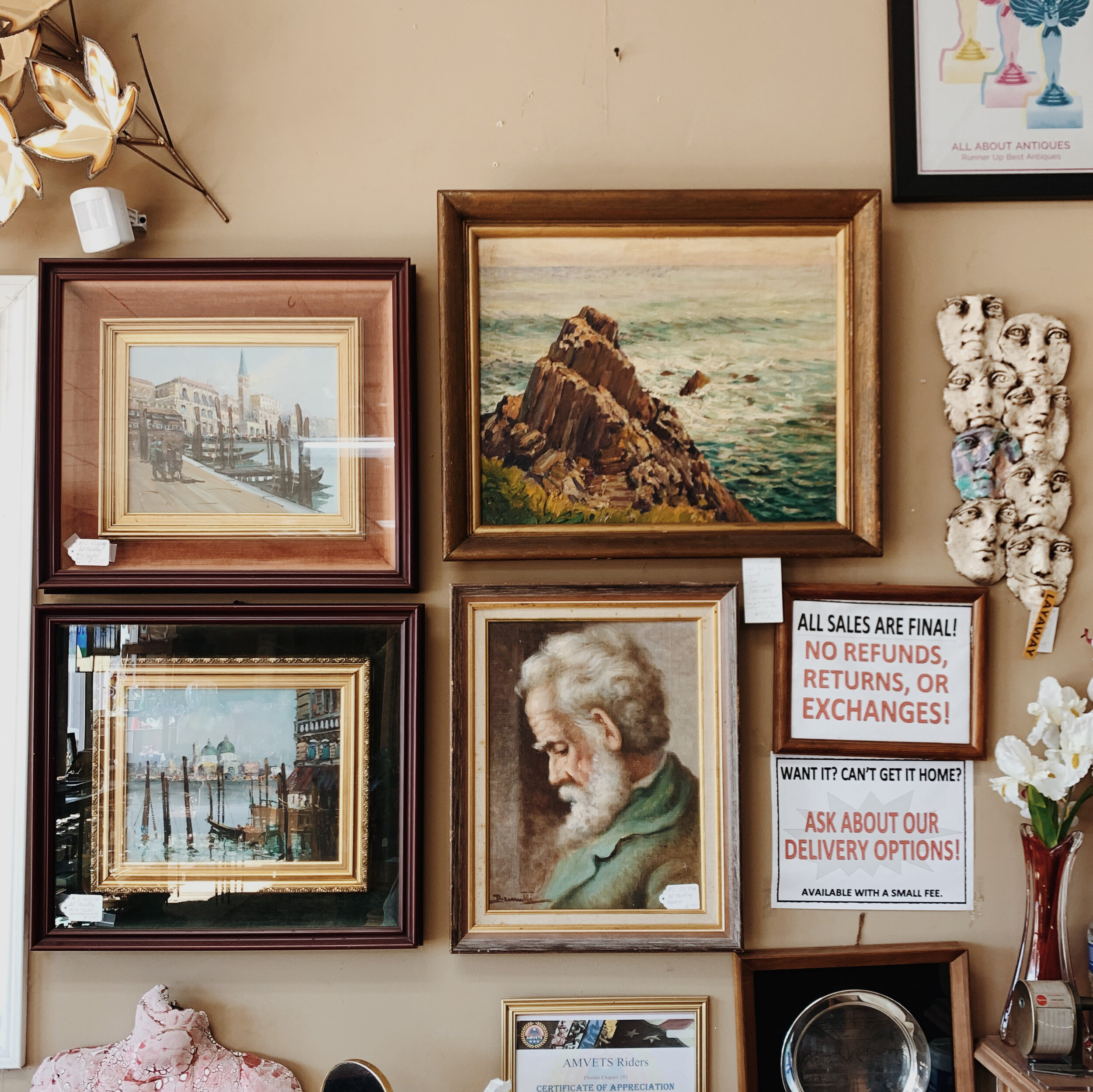A few weeks ago, I walked into an antique store with my mother in law. A painting on the wall caught my attention despite the cluttered neighboring works of art and all-caps signs around it. From my vantage point, the bright colors and beautiful brushstrokes of this seascape scene set this piece apart.
I took a closer look to check the price tag. $950. Of course. (Ethan says I have expensive taste. Every price tag I check confirms his theory, ha. ). A friend once told me that she has learned to appreciate the beautiful and expensive things without feeling the pressure to take them home. We can enjoy them in their own environment. That stuck with me. And so I stood there, oblivious to the surrounding trinkets, observing the movement and texture, envisioning the original scene the artist interpreted with paint.
The store clerk shared my fascination and stopped what he was doing to tell me that the original artist, William Starkweather (1869-1969), was originally from Europe, moved to America as a child and spent the rest of his life studying and making art around the world. He is most known for his impressionist landscape painting and this one is signed. He took the painting off the wall, and showed me the backside. This was no art museum but I believe I got the better experience. I asked him if I could take a picture of the painting for my husband to see and I snapped the above photo.
I’ve thought about that painting since and wondered what Mr. Starkweather would think of his work hanging on that overcrowded, dusty wall. Would he be disappointed that this piece ended up in a consignment shop? Or would he relish in the fact that some stranger appreciates his art several decades later?
Whatever he may have felt, this moment reminded me that the things we create, whether hung in a gallery or lost to a consignment shop, are things left behind.
It’s true. Sometimes these things are treasured for a season. Sometimes treasured for many generations. But sometimes they are lost. Sometimes forgotten. Eventually, moth and rust destroy (Matt. 6:19). They are all passing. “For we brought nothing into the world, and we can take nothing out of it” (1 Tim. 6:7). This is a message that gets lost in the “creative” world.
While art engages all the senses, the visual aspect is a major component. The seeing is a large part of the experience. The photographer takes a picture that people stare upon. The writer pens the words that people read. And with the same vision that we use to create and then to experience, we also use it to measure the success of the creation. We see the “likes.” We see the difference between the painting hung in a gallery versus an old antique shop, and oftentimes we ascribe value to that work based on how it’s perceived by others. Is the oversized canvas with a single painted shape in a modern art museum of more value than the intricate details in the sketchbook of a stay at home mom?
The world may offer an inconsistent picture of “success” but even the accepted greats—the DaVinci’s, Picasso’s, and the like—faced the reality that they could not take their work with them. Their names may be studied by spans of generations but there is only one Name above all names (Philippians 2:9). Countless words may have been written about their lives but only the words of the Lord stand forever (Isaiah 40:8). They may have left an earthly legacy in their work but the only lasting legacy is that of God Himself—He is the beginning and the end (Revelation 22:13).
I am not saying that art is worthless, for this same principle of all-things-passing carries into any material thing. Consider the book I’ve written or the magazine our team creates. Though they serve God-honoring purposes in this period of time, they will not come into eternity with me. This is not to negate the beautiful process of creating or to dismiss the reality that whether in writing, painting, or whatever it is we do, we can bring glory to God. Art offers massive contributions to our present society and its influence is powerful, whether used for good or bad. But when we view art with an eternal lens, then we are free from overvaluing the process and/or the end product. We are free from finding our worth in a famous gallery show or the New York Times best sellers list and we are free from feeling worthless if our work ends up on Goodwill’s shelves. The result for the Christian creator who recognizes these truths is contentment—both contentment in the Lord and contentment in whatever may happen to our work after it is released into the world.


 I struggled to get the initial steps down and had to ask Ethan to help me. (That's what I get for trying to learn from a E-book.) I'm so glad some of his military training gave him a foundation in sewing/knot tying between that knowledge and him watching some Youtube videos, he was the one to help me get started, haha! Once I got the basics down, I found this type of loom weaving to be so incredibly easy (and therapeutic.)
I struggled to get the initial steps down and had to ask Ethan to help me. (That's what I get for trying to learn from a E-book.) I'm so glad some of his military training gave him a foundation in sewing/knot tying between that knowledge and him watching some Youtube videos, he was the one to help me get started, haha! Once I got the basics down, I found this type of loom weaving to be so incredibly easy (and therapeutic.)  Unlike my love for knitting, this didn't leave my fingers aching which made me happy. It sounds lame but I stopped knitting mainly for that reason.
Unlike my love for knitting, this didn't leave my fingers aching which made me happy. It sounds lame but I stopped knitting mainly for that reason. There is also so much freedom to create whatever design or color palette you would like. I didn't follow a pattern and just had fun experimenting with different types of string and techniques.
There is also so much freedom to create whatever design or color palette you would like. I didn't follow a pattern and just had fun experimenting with different types of string and techniques. I didn't realize it until seeing the picture on the right, but clearly my living room was inspiration without me even knowing it, haha.
I didn't realize it until seeing the picture on the right, but clearly my living room was inspiration without me even knowing it, haha. The finished piece is hanging in our living room (for now!) I'm excited to try out more complex techniques and to perfect some of the basics. :) I would love to have some sort of a looming get-together for anyone wanting to learn. I'm definitely not an expert but it would be fun to fill the living room with yarn, warm drinks, and both new and old friends. If you're interested, connect with me!
The finished piece is hanging in our living room (for now!) I'm excited to try out more complex techniques and to perfect some of the basics. :) I would love to have some sort of a looming get-together for anyone wanting to learn. I'm definitely not an expert but it would be fun to fill the living room with yarn, warm drinks, and both new and old friends. If you're interested, connect with me! I've been a little obsessed with abstract art lately. I've found a few awesome artists on Instagram and just love how they can express themselves with paint. They can make something so seemingly random come together and still look cohesive in their own personal way. Ethan thinks it's a joke. In a way, I don't blame him. He took a college art class in California and studied some of the best so I know these paintings don't hold up to those standards for him. Regardless, I was inspired and so the kids and I went to our local craft store a few weeks ago to grab some supplies. These are just a few pictures from that afternoon.
I've been a little obsessed with abstract art lately. I've found a few awesome artists on Instagram and just love how they can express themselves with paint. They can make something so seemingly random come together and still look cohesive in their own personal way. Ethan thinks it's a joke. In a way, I don't blame him. He took a college art class in California and studied some of the best so I know these paintings don't hold up to those standards for him. Regardless, I was inspired and so the kids and I went to our local craft store a few weeks ago to grab some supplies. These are just a few pictures from that afternoon. I wanted them to express themselves freely with paint. They are at an age where there is no comparison or thought of how things are supposed to look. They really did great. But then again their art is always a masterpiece to me.
I wanted them to express themselves freely with paint. They are at an age where there is no comparison or thought of how things are supposed to look. They really did great. But then again their art is always a masterpiece to me. Surprisingly, it was actually me who struggled quite a bit with it all. Honestly, it's much harder than it looks. I suppose technically their is no wrong way to go about it but there is still thought behind the strokes and work in mixing colors. Eventually I got into a groove and was happy with the way my piece turned out...though you would be shocked to see how many layers of paint are underneath the finished product, ha.
Surprisingly, it was actually me who struggled quite a bit with it all. Honestly, it's much harder than it looks. I suppose technically their is no wrong way to go about it but there is still thought behind the strokes and work in mixing colors. Eventually I got into a groove and was happy with the way my piece turned out...though you would be shocked to see how many layers of paint are underneath the finished product, ha.
 I think this will need to be a regular thing for us all. It sure was fun and now we have art to hang up on the walls that the kids are proud of.
I think this will need to be a regular thing for us all. It sure was fun and now we have art to hang up on the walls that the kids are proud of.